Functional Jaw Corrections in Children
Uncompromised quality
We use quintessential quality materials and stringent sterilisation protocols to ensure that you don't have any medical or dental complications in future.
Anxiety Free Dentistry
Experience the treatment process in a pleasant atmosphere from handpicked expert clinicians, with unparalleled clinical etiquette, to ensure exemplary health care.
Best in class outcomes
We strive our best, so that we can keep our promise of delivering the individualized smiles that we have reimagined for you with latest techniques and technologies.
Functional jaw correction / Growth Modulation Treatment
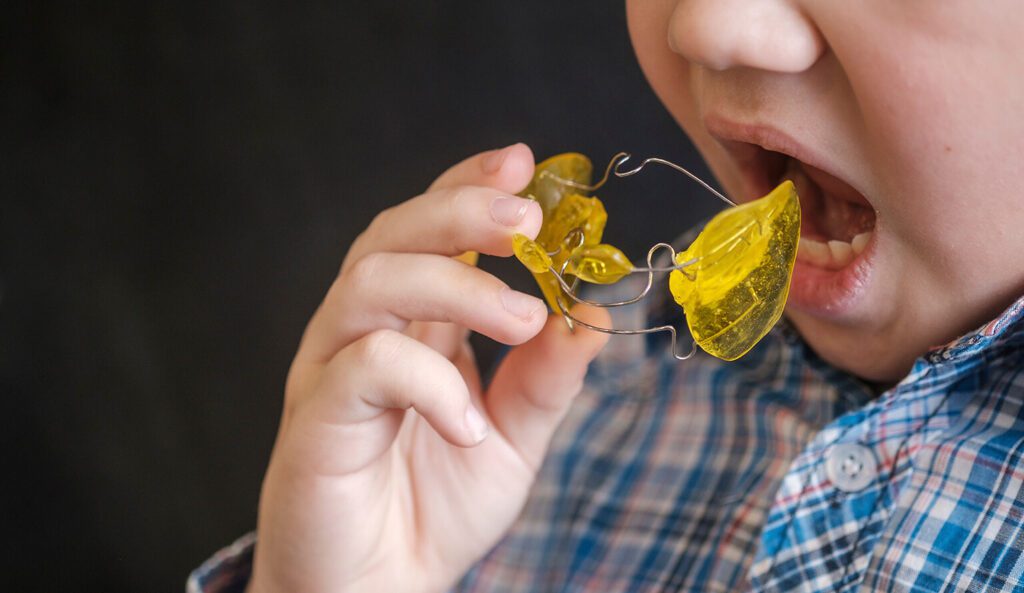

Underdeveloped jaws in children is a common condition where the lower or upper jaw does not grow to its full potential, leading to a discrepancy in the size or shape of the jaw compared to the rest of the face. This condition can impact the child’s oral functions, speech, and self-esteem.
Symptoms of underdeveloped jaws in children may include difficulty biting and chewing food, speech difficulties, and a face that appears unbalanced or asymmetrical. Children with underdeveloped jaws may also experience problems with self-esteem and may feel self-conscious about their appearance.
Fortunately, there is treatment known as myofunctional treatment or growth modulation treatment that can be used to correct underdeveloped jaws in children. That treatment is non-surgical functional jaw correction with various functional appliances, followed by which orthodontic treatment such as braces or aligners is done. This treatment in children utilises growth potential of their jaws during their growing years ( 6 – 14 years ) and enhance the growth that has been stunted, by utilising various methods and help them achieve the growth of their jaws to the extent as much as possible.
When children in their growing years with jaw problems or functional problems does not undergo this functional jaw correction treatment, the treatment option they are left with after their growing years is orthognathic surgery, which involves repositioning the jaw bones to their correct position. In some cases, a combination of both orthodontic treatment and surgery may be necessary to achieve the best results.
- Underdeveloped lower jaw with normal upper jaw.
- Underdeveloped upper jaw with normal lower jaw.
- Underdeveloped upper and lower jaws.
- Overdeveloped lower jaw with normal upper jaw.
- Overdeveloped upper jaw with normal lower jaw.
- Overdeveloped upper jaw with Underdeveloped lower jaw.
- Overdeveloped lower jaw with underdeveloped upper jaw.
- Overdeveloped upper and lower jaws.
There are several factors that can contribute to underdeveloped jaws in children. Some of the most common causes include:
- Genetics: Jaw growth and development are influenced by a child’s genetic makeup. Some children are predisposed to having underdeveloped jaws due to their family history.
- Habit disorders: Thumb-sucking, mouth-breathing, and prolonged use of pacifiers can all contribute to jaw growth deficiencies in children.
- Craniofacial anomalies: Certain craniofacial anomalies, such as cleft lip and palate, can also impact jaw growth and development.
- Trauma: Physical trauma to the jaw area can cause damage to the growth plates, leading to underdeveloped jaws.
- Nutrition: A lack of vitamins and minerals essential for jaw growth and development can contribute to underdeveloped jaws.
- Health problems: Certain health conditions, such as sleep apnoea and hypothyroidism, can also impact jaw growth and development.
It is important to note that in some cases, the cause of underdeveloped jaws in children may not be fully understood. Early diagnosis and treatment by an orthodontist can help ensure that the child’s jaw growth and development are on track.
There are several steps in the treatment to correct underdeveloped jaws in children. Those steps are mentioned below sequentially:
- Growth Modulation Therapy: The first and foremost step is to utilise the growth of the child as much as possible to achieve the growth of the jaws naturally to as much as extent possible. To achieve this growth naturally, the stunted growth of the jaws has to enhanced, which is done with the help of various functional appliances, that are custom made according to the need of every child, after proper diagnosis of the main cause for the stunt in growth of their jaws.
- Orthodontic treatment: Followed by growth modulation is the orthodontic treatment phase, where the correction of jaws achieved by growth modulation is maintained and more correction of angulation of teeth is done to correct the proclination and retroclination of teeth. This proper combination of correcting jaws and then aligning the teeth on the jaws helps the child improve not only his looks but also corrects his other functional abnormalities like speech, chewing, breathing problems etc.
- Upper Jaw Expansion: In some children, an upper jaw expansion procedure which is a functional treatment that is used to widen the upper jaw and promote proper growth and development is needed. This treatment typically is done for a period of time to gradually increase the width of the upper jaw.
The choice of treatment will depend on the specific needs and case of the individual child, and an orthodontist will work with the child and their parents to determine the best course of action. It is important to note that early intervention is key when it comes to correcting underdeveloped jaws in children, so it is important to seek the advice of an orthodontist as soon as possible.
Correcting underdeveloped jaws in children has numerous benefits, including:
- Better bite: Correcting underdeveloped jaws can help improve the bite, reducing the risk of dental problems such as jaw pain, tooth grinding, and temporomandibular joint (TMJ) disorders.
- Improved speech & Airway: Children with underdeveloped jaws may experience speech & airway difficulties, and correcting the jaws can improve their speech, pronounciation and ability to breath.
- Improved facial appearance: Correcting underdeveloped jaws can help improve the appearance of the face, creating a more balanced and harmonious appearance.
- Enhanced self–esteem: Children who are self-conscious about their appearance may experience improved self-esteem and confidence as a result of treatment.
- Improved oral health: Correcting underdeveloped jaws can help ensure proper alignment of the teeth, reducing the risk of dental problems such as cavities and gum disease.
- Improved function: Correcting underdeveloped jaws can help improve overall jaw function, reducing the risk of jaw pain, tooth grinding, and other related problems.
If underdeveloped jaws in children are not corrected, a number of negative consequences can occur, including:
- Persistent jaw pain and discomfort: Children with underdeveloped jaws may experience persistent jaw pain and discomfort due to misalignment of the jaws and teeth.
- Speech & Airway difficulties: Children with underdeveloped jaws may experience speech & airway difficulties, such as difficulty pronouncing certain words or a lisp and difficulty breathing.
- Dental problems: Children with underdeveloped jaws may be at an increased risk of dental problems, such as cavities, gum disease, and tooth decay.
- Temporomandibular joint (TMJ) disorders: Children with underdeveloped jaws may be at an increased risk of developing temporomandibular joint (TMJ) disorders, which can cause jaw pain and discomfort.
- Reduced self–esteem: Children who are self-conscious about their appearance may experience reduced self-esteem and confidence if their underdeveloped jaws are not corrected.
- Persistence of the underdeveloped jaw: If left untreated, an underdeveloped jaw may persist into adulthood, leading to long-term problems with bite, jaw function, and appearance.
If you suspect your child may have an underdeveloped jaw, it is important to seek the advice of an orthodontist as soon as possible. With the right treatment, children with jaw growth deficiencies can achieve a healthy, functional, and attractive smile that will serve them well into adulthood. If the misaligned jaws are to be fixed in non-growing patients, orthognathic surgery is the available option. Read on to know more about it.
All of us here at Kigo Dental are committed to providing you with the best dental care available, and we do so with a smile.
Our entire staff, from receptionists to dental hygienists and assistants, is committed to providing you with the best quality dental care possible.
From the time you walk through the door and every time you revisit, you will experience this firsthand.
Kigo Dental has a team of experienced and skilled Orthodontists and other specialised dentists who specialise in providing high-quality dental care and treatments, utilising the latest technologies and techniques to ensure the best outcomes for their patients.
FAQ's
Jaw malocclusion refers to an abnormality in the alignment of the teeth and jaws, which can result in functional and aesthetic problems.
Jaw malocclusion can be caused by various factors like genetics, dental problems, childhood habits (such as thumb sucking), and trauma to the face or jaw etc.
Treatment options for jaw malocclusion in children may include braces, myofunctional orthopaedic appliances, headgear, jaw surgery and other appliances or devices.
The appropriate age for jaw malocclusion treatment depends on the child’s needs and the severity of the malocclusion. Usually, treatment options start as early as possible to utilise the child’s jaw growth potential, typically around age 6 – 8 for girls and 7 – 9 for boys.
The length of treatment for jaw malocclusion in children can vary depending on the severity of the malocclusion and the treatment approach used. Treatment can range from a few months to several years.
Jaw malocclusion treatment can cause a little discomfort, particularly in the first few days or weeks after starting treatment. However, most children adapt well to treatment and pain can be managed with pain medication or other strategies.
Wearing a retainer after treatment is common to help maintain the results achieved with treatment. The type and duration of retainer wear will depend on the individual case and treatment plan.
Growth modulation jaw correction is a treatment method used to correct the position and alignment of the jaws in growing children. It involves using orthodontic appliances and techniques that modify the growth of the jaws to achieve a better functional and aesthetic outcome.
There are several types of growth modulation jaw correction techniques, including functional appliances, headgear, rapid palatal expansion, and orthognathic surgery.
A functional appliance is a type of orthodontic appliance that is designed to modify the growth and position of the jaws. It typically consists of an upper and lower device that works together to move the jaws into a more optimal position.
Headgear is an orthodontic appliance that is worn outside the mouth to apply gentle pressure to the teeth and jaws. It is often used to correct overbites and underbites in growing children
Rapid palatal expansion is a technique that is used to widen the upper jaw to create more space for the teeth and improve breathing. It involves using an orthodontic appliance that is attached to the upper teeth and exerts gentle pressure to widen the palate.
Growth modulation jaw correction can be performed in growing children and teenagers, typically between the ages of 6 and 18. The exact timing of treatment will depend on the individual child’s growth and development.
The duration of growth modulation jaw correction treatment varies depending on the individual case and the specific treatment technique used. It can range from several months to several years.
As with any medical or dental treatment, there are risks and potential complications associated with growth modulation jaw correction. These may include tooth or jaw pain, difficulty speaking or eating, and temporary or permanent changes in facial appearance. Your orthodontist or oral surgeon can discuss the specific risks and potential complications of the treatment with you.
Blogs
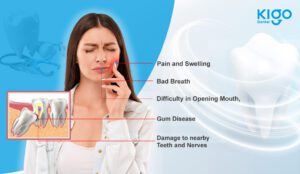





Wisdom Teeth: Understanding the What, Why, and When
Wisdom teeth, also known as third molars, are often a source of concern for many people. They can lead to various dental issues, including wisdom
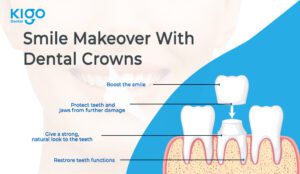





Smile Makeover with Dental Crowns: Types, Overview & cost
A smile is one of the most attractive features a person can have. It can boost your confidence, make you more approachable, and even improve






Beyond the smile: Exploring the crucial role of teeth in your overall health
Teeth are often linked to the ability to smile, eat, and express oneself. However, teeth serve many other vital purposes as well. Your teeth have
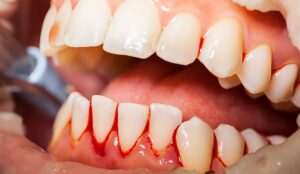





The Silent Threat: How Gum Diseases Lead to Tooth Loss
Having strong teeth and gums is a reflection of your entire well-being, not simply your appearance. Despite this, many people don’t give their gums the
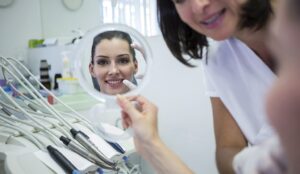





The Importance of Orthodontists in Clear Aligner Treatment: Avoiding Problems and Ensuring Successful Outcomes
More and more individuals are seeking out clear aligner treatment as a way to improve their smile in a way that is both subtle and






Understanding Abnormal Dental Habits in Children and the Importance of Control
As parents and caregivers, we play a pivotal role in shaping our children’s habits and behaviors, especially when it comes to their oral health. However,






Wisdom Teeth: Understanding the What, Why, and When
Wisdom teeth, also known as third molars, are often a source of concern for many people. They can lead to various dental issues, including wisdom






Smile Makeover with Dental Crowns: Types, Overview & cost
A smile is one of the most attractive features a person can have. It can boost your confidence, make you more approachable, and even improve






Beyond the smile: Exploring the crucial role of teeth in your overall health
Teeth are often linked to the ability to smile, eat, and express oneself. However, teeth serve many other vital purposes as well. Your teeth have






The Silent Threat: How Gum Diseases Lead to Tooth Loss
Having strong teeth and gums is a reflection of your entire well-being, not simply your appearance. Despite this, many people don’t give their gums the






The Importance of Orthodontists in Clear Aligner Treatment: Avoiding Problems and Ensuring Successful Outcomes
More and more individuals are seeking out clear aligner treatment as a way to improve their smile in a way that is both subtle and






Understanding Abnormal Dental Habits in Children and the Importance of Control
As parents and caregivers, we play a pivotal role in shaping our children’s habits and behaviors, especially when it comes to their oral health. However,






Wisdom Teeth: Understanding the What, Why, and When
Wisdom teeth, also known as third molars, are often a source of concern for many people. They can lead to various dental issues, including wisdom






Smile Makeover with Dental Crowns: Types, Overview & cost
A smile is one of the most attractive features a person can have. It can boost your confidence, make you more approachable, and even improve






Beyond the smile: Exploring the crucial role of teeth in your overall health
Teeth are often linked to the ability to smile, eat, and express oneself. However, teeth serve many other vital purposes as well. Your teeth have






The Silent Threat: How Gum Diseases Lead to Tooth Loss
Having strong teeth and gums is a reflection of your entire well-being, not simply your appearance. Despite this, many people don’t give their gums the






The Importance of Orthodontists in Clear Aligner Treatment: Avoiding Problems and Ensuring Successful Outcomes
More and more individuals are seeking out clear aligner treatment as a way to improve their smile in a way that is both subtle and






Understanding Abnormal Dental Habits in Children and the Importance of Control
As parents and caregivers, we play a pivotal role in shaping our children’s habits and behaviors, especially when it comes to their oral health. However,






Wisdom Teeth: Understanding the What, Why, and When
Wisdom teeth, also known as third molars, are often a source of concern for many people. They can lead to various dental issues, including wisdom






Smile Makeover with Dental Crowns: Types, Overview & cost
A smile is one of the most attractive features a person can have. It can boost your confidence, make you more approachable, and even improve






Beyond the smile: Exploring the crucial role of teeth in your overall health
Teeth are often linked to the ability to smile, eat, and express oneself. However, teeth serve many other vital purposes as well. Your teeth have






The Silent Threat: How Gum Diseases Lead to Tooth Loss
Having strong teeth and gums is a reflection of your entire well-being, not simply your appearance. Despite this, many people don’t give their gums the






The Importance of Orthodontists in Clear Aligner Treatment: Avoiding Problems and Ensuring Successful Outcomes
More and more individuals are seeking out clear aligner treatment as a way to improve their smile in a way that is both subtle and






Understanding Abnormal Dental Habits in Children and the Importance of Control
As parents and caregivers, we play a pivotal role in shaping our children’s habits and behaviors, especially when it comes to their oral health. However,






Wisdom Teeth: Understanding the What, Why, and When
Wisdom teeth, also known as third molars, are often a source of concern for many people. They can lead to various dental issues, including wisdom






Smile Makeover with Dental Crowns: Types, Overview & cost
A smile is one of the most attractive features a person can have. It can boost your confidence, make you more approachable, and even improve






Beyond the smile: Exploring the crucial role of teeth in your overall health
Teeth are often linked to the ability to smile, eat, and express oneself. However, teeth serve many other vital purposes as well. Your teeth have






The Silent Threat: How Gum Diseases Lead to Tooth Loss
Having strong teeth and gums is a reflection of your entire well-being, not simply your appearance. Despite this, many people don’t give their gums the






The Importance of Orthodontists in Clear Aligner Treatment: Avoiding Problems and Ensuring Successful Outcomes
More and more individuals are seeking out clear aligner treatment as a way to improve their smile in a way that is both subtle and






Understanding Abnormal Dental Habits in Children and the Importance of Control
As parents and caregivers, we play a pivotal role in shaping our children’s habits and behaviors, especially when it comes to their oral health. However,
LET'S TALK
Book your Appointment
Appointment Timings: Mon-sat: 10:00 am- 8:00 pm |
Sun: 10:00 am - 1:00 pm
Contact
We would love to be a part of your Smile Reimagining Journey...
- 2nd Floor, QUBE, Plot No: 3-64/A, Kavuri Hills Rd, Jubilee Hills, Hyderabad, Telangana 500033
-
+91 9998884398
- kigodental@gmail.com
-
Mon - Sat: 10:00 am - 8:30 pm
Sun: 10:00 am - 1:00 pm